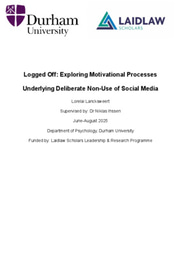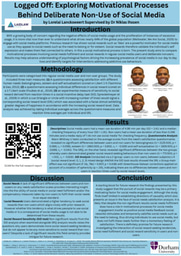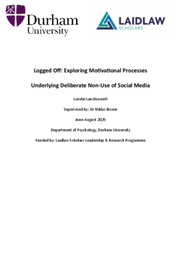Logged Off - Exploring Motivational Processes Underlying Deliberate Non-Use of Soocial Media
INTRODUCTION
Shaping how individuals today communicate, interact and satisfy social needs, the presence of social media grows ever more prevalent with many expressing concerns for issues involving problematic usage and feelings of discontent related with this usage. Several studies have connected social media usage with loss of creativity, motivation, social skills as well as feelings of loneliness and anxiety (Rao et al, 2022. Singh et al, 2017). Needless to say, there are mixed feelings about the benefit cost analysis of social media usage and some seem to think the costs outweigh the benefits. Social media non- users can bring to mind the vision of some sort of hermit sequestered in a little cottage in the woods and whilst for many it may be some problem of access for others it is an active decision. A study conducted by ORIGIN (Kale, 2018) revealed that 34% of Generation Z social media users have permanently quit social media usage citing issues such as loss of time and lack of reality. 63.9% of the world’s population use social media, the assumption being a large part of the non-users simply do not have access however with 5.8% of the worlds internet users also lacking a social media presence (Meltwater; We Are Social, 2025) the conclusion can be drawn that for many social media abstinence is a decision – whether abstinence or simply not feeling the need social media non-use is an interesting avenue to explore in understanding social media usage.
Examining motivational processes behind non-use through the lens of social needs and neuroticism also provides promise. Maslow’s Hierarchy of Social Needs is an approach based on the drive theory; the theory that ‘certain things are required by all human beings for the continuation of their lives or for their wellbeing” (Hull, 1951; Spence, 1958). Maslow (1943) posited that these needs develop from the most basic (physiological, safety-security) to higher order needs (belonging, esteem and self-actualization). In order to fulfil higher tiered needs, the basic ones must first be mostly satisfied. Already the applications for social media usage are evident; as a tool to fulfil social needs. However, it is also evident the extent to which social media can become a crutch, impairing social need fulfilment. Taormina (2013) correlates fulfilment of Maslow’s needs with increased life satisfaction, demonstrating how vital it is to fulfil these levels. Research also suggests fulfilment on the highest tier (self-actualization) leads to decreased social media usage, begging the question whether satisfaction of all the tiers, without social media usage, motivates social media non-use (Ghatak, 2019).
Given the distinct lack of literature on social media non-use, this research would fill a gap in investigating an aspect of the motivational processes behind social media abstinence. Specifically asking the following research questions:
- Do social media nonusers show increased fulfilment of social needs than users?
- Do social media nonusers show increased life satisfaction than users?
METHODOLOGY
The study would use a non-experimental design, making use of questionnaires such as the Life Satisfaction Index (LSI) and Taormina’s needs fulfilment assessments scaled on Likert scales 1-5 in order to establish satisfaction on all variables. This design will allow for maximum engagement as it is easily applicable, fast and reach a wider audience. A possible difficulty may occur in identifying social media nonusers which attempts to overcome will be made using newspaper and internet ads. A literature review will also be conducted to give a full overview of the topic at hand.
Following data collection, a complete quantitative statistical analysis will take place between the two groups (users and non-users) using methods such as but not limited to independent t-tests, Mann-Whitney U tests and ANCOVA. Results will be assessed and analysed to determine differences between users and non-users on the three variables: social need fulfilment, life satisfaction and neuroticism.
IMPLICATIONS
When seen to fruition this research should produce a well-rounded report on some of the motivational processes behind social media non-use. Whilst unable to establish causation by the nature of being a correlational study, the research may begin to examine the relationship between social needs and problematic social media usage through the lens of non-users. Serving perhaps as the starting point for further research into motivational processes underpinning social media non-use which could in turn have outputs vital to the understanding of how to curb problematic usage. In this way the research results may have a potential social impact beneficial to those attempting to decrease social media usage. Vitally, if the results follow the hypothesis further study could investigate how nonusers fulfil their social needs by other means than social media and apply to users in order to diminish problematic social media usage.
REFERENCES
Ghatak, S., & Singh, S. (2019). Examining Maslow’s Hierarchy Need Theory in the Social Media Adoption. FIIB Business Review, 8(4), 292–302. https://doi.org/10.1177/2319714519882830
Hull, C. L. (1951). Essentials of behaviour. Yale University Press.
Maslow, A. H. (1943). A THEORY OF HUMAN MOTIVATION.
Meltwater, & We Are Social. (2025). Global social media Statistics.
Rao, N., David, V., & Kalyani, V. (2022). A Study on Positive and Negative Effects of Social Media on Society. Journal of Science and Technology, 7(10), 2456–5660. https://doi.org/10.46243/jst.2022.v7.i10.pp46
Singh, M. M., Amiri, M., & Sabbarwal, S. (2017). Social Media Usage: Positive and Negative Effects on the Life Style of Indian Youth Peer review under responsibility of Iranian Journal of Social Sciences and Humanities Research. In Iranian Journal of Social Sciences and Humanities Research UCT. J. Soc. Scien. Human. Resear (Vol. 5). http://UCTjournals.com
Sirin Kale. (2018). Logged off: meet the teens who refuse to use social media. The Guardian.
Spence, K. W. (1958). A theory of emotionally based drive (D) and its relation to performance in simple learning situations. American Psychologist, 13(4), 131–141.
Taormina, R. J., & Gao, J. H. (2013). Maslow and the Motivation Hierarchy: Measuring Satisfaction of the Needs. In American Journal of Psychology Summer (Vol. 126, Issue 2).



Please sign in
If you are a registered user on Laidlaw Scholars Network, please sign in